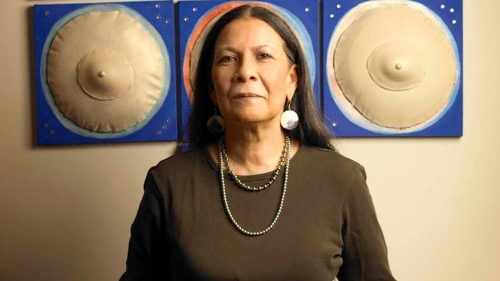Nadema Agard (BS ’70, Cherokee/Lakota/Powhatan) is a visual artist, illustrator, curator, educator, lecturer, storyteller, writer, poet, published author, museum professional, Indigenous rights advocate and consultant in Repatriation and Multicultural/Native American arts and cultures.
Agard, who was awarded the NYU Steinhardt Dorothy Height Distinguished Alumni Award in 2021, was drawn to art from a young age; her father was a portrait artist, and she “realized that art was something important early on.”
“In junior high, I wanted to be a dancer, but unfortunately my parents couldn’t afford the lessons,” says Agard. “Instead, I focused on art and attended the High School of Music & Art in Manhattan. But I also knew I wanted to teach, so I applied to NYU and got a full scholarship.”
Agard was one of the few Native American students at NYU at the time; in fact, she and fellow student Charmaine Lyons Shenandoah helped to found the first American Indian club at the University.
“I loved my studio art classes at Steinhardt, and I worked with some well-known and respected artists – Robert Kaupelis for drawing, Knox Martin for painting, Robert Blackburn for print-making,” says Agard. “The area around NYU had so much character back then; going out into the Village was the greatest thrill of my life when I was younger.”

Nadema Agard (BS '70)
After graduating with her degree in art education, Agard immediately began teaching art at Booker T. Washington Junior High. It wasn’t an easy job, in part due to a teacher’s strike as well as having energetic kids who were “walking on tables and almost as big as [she] was.”
“I wrangled them into shape and made their lives more interesting with art,” says Agard, who still hears from students via social media telling her what an impact she made as a teacher.
After working for several years as a teacher in various schools and continuing to make art on the side, Agard was invited in 1979 to show her work at the American Indian Community House, where she later became a curator.
“In New York City, it was impossible to be in a gallery as a person of color back then,” says Agard. “We needed a place to exhibit, and for me, that became ‘my’ gallery where I exhibited a lot over the years.”
Agard left her teaching job in 1981 to take a role at the Museum of the American Indian – a dream job for her in which she curated many installations and ran the Native arts program called “So the Spirit Flows.” In 1988, she received a National Endowment for the Arts Fellowship to write her Southeastern Native Arts Directory; she also returned to her maternal ancestral homelands in the Carolinas and her paternal grandmother’s homeland in Virginia.
I find it especially important right now to reiterate that the idea of different races is a manmade concept. In the Lakota tradition, we are one human race in different colors.
Almost a decade later as the repatriation director of the Standing Rock Sioux Tribe, she was again re-united with her paternal grandfather’s Lakota relatives in the Dakotas who had, five years earlier, arranged for her to receive her Lakota name ‘Winyan Luta’ during a naming ceremony officiated by a traditional elder. Although her name, in the Lakota language, literally means ‘Woman Holy Red’ with the word ‘luta’ as ‘holy red’, it can only be translated into English as Red Woman.
Agard has continued to exhibit her artwork – a contemporary take on the images and cosmologies from various Native American traditions – both domestically and internationally. She is currently working on a large, 28-piece installation called “Hoop Dreams” that is about a vision about the world had as a child by Black Elk, an Oglala Lakota holy man.
“The hoops symbolize our nations of people, the idea inclusiveness, and the oneness of the human race – a theme I do a lot of work around,” says Agard. “I find it especially important right now to reiterate that the idea of different races is a manmade concept. In the Lakota tradition, we are one human race in different colors.”
